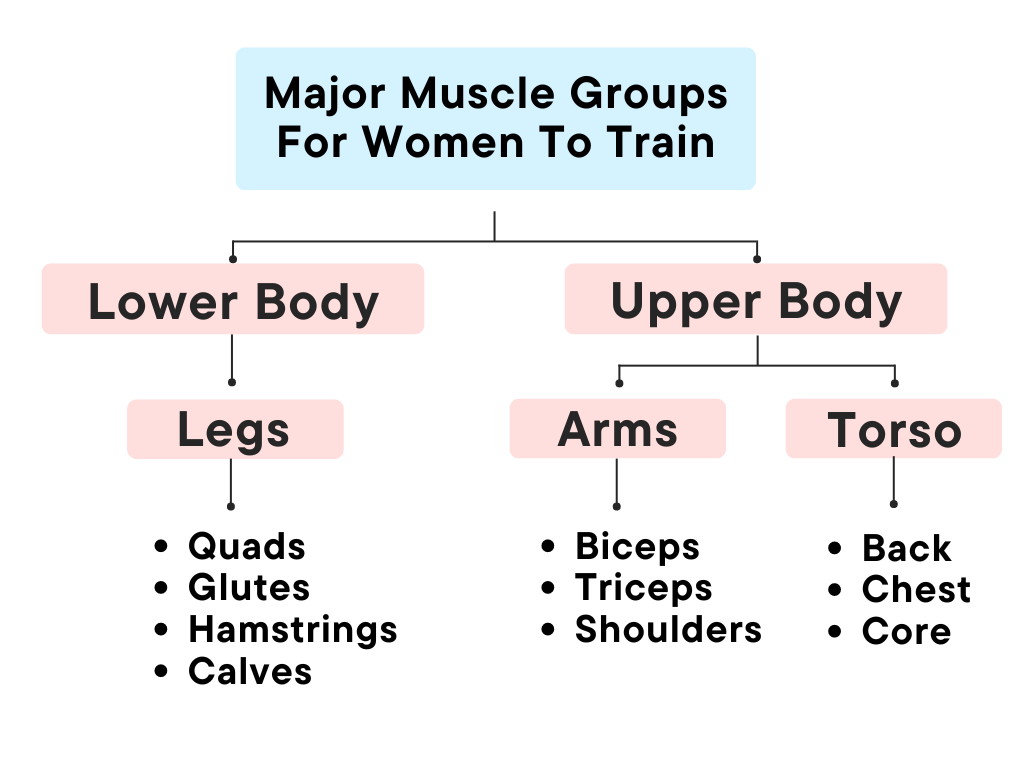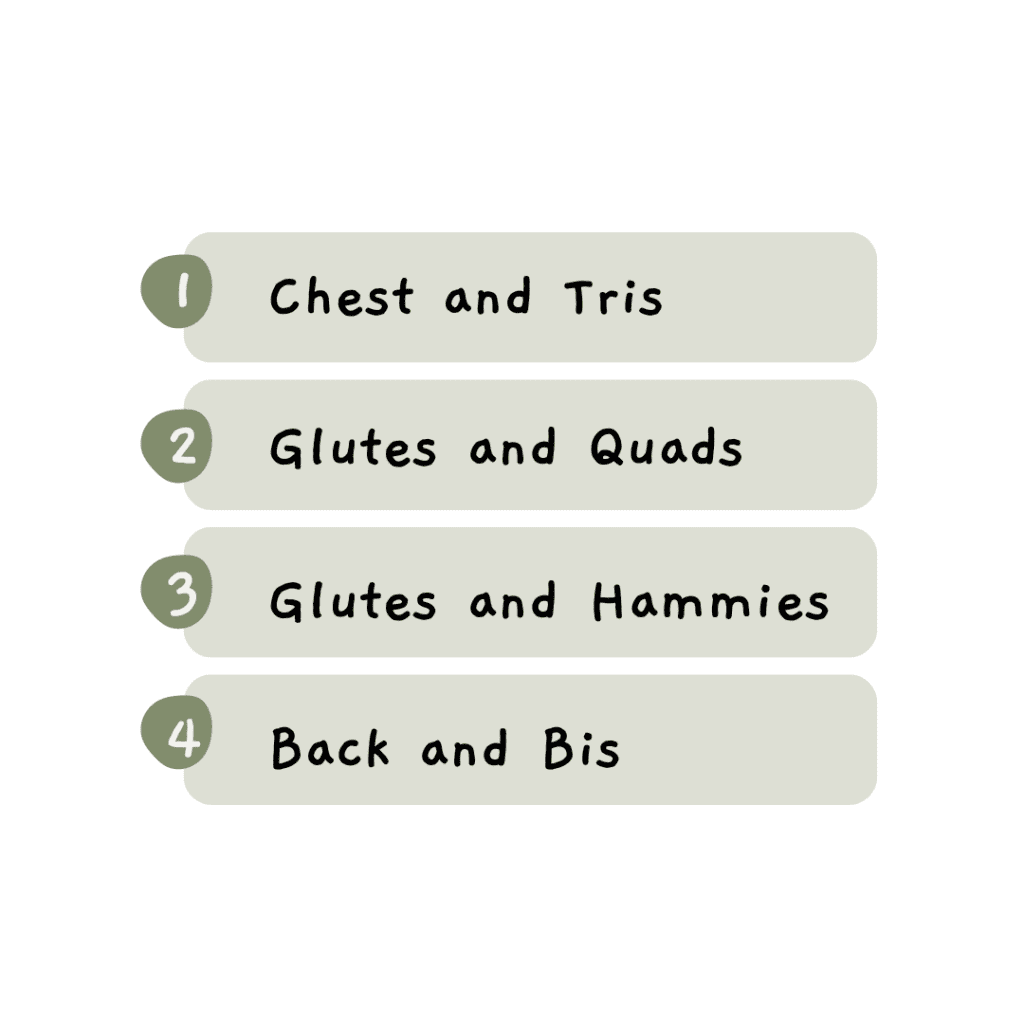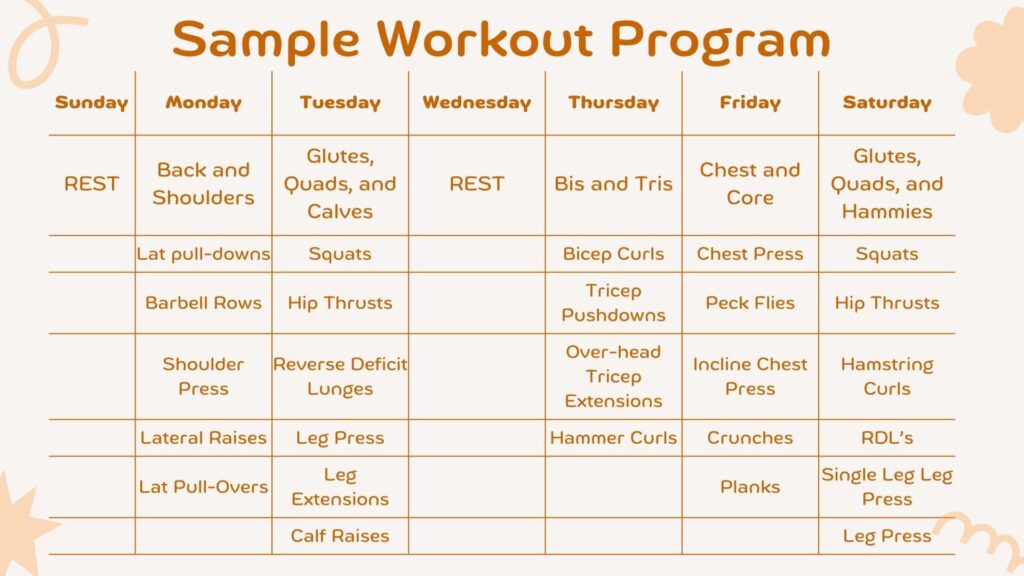If you’re just getting into the gym and are feeling slightly, or not so slightly, overwhelmed about starting things out, you’re in the right spot.
One of the biggest challenges beginner weightlifters face is understanding the muscles in their body.
That is, understanding which muscles are absolutely critical for you to train in an effective, well-rounded workout routine.
I mean, there are so many different muscles in your body, how could you possibly ever train every single one?
Well, that’s why most weightlifters narrow things down to the most important muscle groups.
In this post, I want to explore the key muscle groups women should train and how to implement them into an effective strength training program.
In This Post You’ll Find:
- Why it’s important for women to train these key muscle groups
- More muscle mass makes achieving weightlifting goals easier
- The 10 essential muscle groups women should train in the gym for effective workouts
- How to implement training these muscle groups into your weightlifting routine
- Combining muscle groups into a “split”
- Example 7-Day Training Split to Effectively Train Each Muscle Group
- Takeaways
- More of my posts on women’s weightlifting and fitness:
Why it’s important for women to train these key muscle groups
As a weightlifter, there are tons and tons of potential muscles in your body for you to be training.
Especially as a beginner entering the gym, it can seem really overwhelming to know what muscles in your body you should be training.
To help simplify things, especially in the beginning, we can narrow it down to a few key muscle groups that should be part of everyone’s routine.
I’d say it’s mostly non-negotiable to target these specific muscle groups because they play some pretty huge roles in your body.
And by growing them, you give yourself the most potential to see the maximum amount of progress.
Not only that, but these are also some of the biggest muscles in your body.
Training them allows you to see maximum results from your weightlifting routine, right from the beginning.
More muscle mass makes achieving weightlifting goals easier
Think about it, if most of our weightlifting goals are achieved from building muscle, then it makes sense that we’d want to train the muscles that have the biggest potential for growth.
That would give ourselves the most potential for muscle growth. And because of that, the most potential to see the benefits of weightlifting!
Additionally, since these are some of the biggest muscles in our bodies, that means we can grow them a lot more than smaller muscles in our bodies.
So they’ll be able to transform our appearance and physique a lot more and a lot easier.
As well as will be extremely impactful on and have the most potential to transform our bodies.
As a result, maximum muscle mass allows us to:
- Have a boosted metabolism
- Gain muscle and lose stubborn fat easier
- Body recomp more effectively
- Transform our physiques
- Lean out and tone down more effectively
So the first step to being on the road to see all this maximum growth and maximum results?
It’s first to become aware of what these muscles are and where they are in your body.
Then to learn how to effectively target and train these muscles in your workout program.
The 10 essential muscle groups women should train in the gym for effective workouts
Below is a list of all ten of the essential muscle groups women should be training in the gym.
The first step to learning how to effectively target these muscles is first becoming aware of them and where they are in your body.
Essential Muscles to Train in Your Lower Body
Below are some of the biggest muscle groups in your legs. Training them will allow you to create the biggest, most defined legs.
Essential Muscles to Train in Your Legs
1. Glutes
Your glutes include your butt and your hips.
2. Quads
These are the muscles on the upper, front side of your legs.
3. Hamstrings
Your hamstrings are the muscles on the upper, back side of your legs.
4. Calves
Your calves are the muscles on the back side of your lower legs. Opposite your shins.
Essential Muscles to Train in Your Upper Body
It’s pretty common for women to train lower body in the gym.
However, there are also tons and tons of benefits to women training upper body as well. And that’s one of the reasons why it’s essential for women to be training upper body in the gym.
Below are all the major muscle groups to train in your upper body.
1. Chest
Your whole chest includes the front of your upper midsection.
2. Back
Your back includes the whole backside of your midsection, all the way from your neck down to your glutes.
Including the sides under your arms, these are called your lats and are also back muscles.
3. Your core
Primarily your abs and around your midsection.
Essential Muscles to Train in Your Arms
The biggest muscles in your arms you’ll want to be training are:
1. Biceps
The upper, front side of your arms.
2. Triceps
The upper, back side of your arms.
3. Shoulders
The very top of your arms.
To help you visualize these essential muscles even better, here’s a basic flowchart:

How to implement training these muscle groups into your weightlifting routine
So that’s great, we now know of all the major muscle groups we should be training in the gym.
Becoming aware of where in our bodies these muscles are is the first step to effectively create a routine to target these parts.
However, there’s still one major question left unanswered.
And that is, how do we actually implement training all these muscle groups in our routines?
Or, better yet, how do we create an effective routine that targets each of these muscles weekly?
Combining muscle groups into a “split”
You might be thinking that there are way too many essential muscle groups to be training them all in a single, weekly routine.
And you’d be right, if we didn’t have strategies to make training these muscles more effective and easier.
One of those strategies is to create a weekly gym split that combines multiple muscle groups on the same day.
By doing this, you’re creating an effective routine that successfully implements all these muscle groups into a single week of training.
OK, seems fairly simple.
So now, once we go to create our gym split, there’s just a few more things for us to consider.
Those things are:
Your gym goals – You’ll want to keep in mind which muscles you want to grow the most. These are the muscles you should be training the most weekly, likely two times per week.
Rest – Rest is extremely important for women who weight train. You’ll want to make sure you’re taking enough rest days as well as allowing for enough rest between training muscle groups.
Which muscles work best together – Understanding which muscles work together in the gym is a major key in determining when you should be training each muscle group.
Understanding which muscle groups work best together
It’s important to note that some muscle groups work together during certain exercises in the gym.
Top Muscle Groups That Work Together:

Knowing this can give you two different approaches to creating your routine:
1. Train muscles that work together on the same day since they’ll already be working and engaged.
2. Train muscles that you know work together on separate days, that way you can train them multiple times per week.
Let’s look into an example using your back and bis to help clarify these strategies.
Since your back and bis are two muscle groups that typically work together.
The First Approach:
If you take the first approach, you would train back and bis on the same day.
Since your biceps work during your back exercises, both your back and bis would already be working on your back day.
Because of this, you’d target each muscle group individually, since they’re both already being targeted together.
The Second Approach:
Whereas if you take the second approach, you would likely train back one day, then train biceps on a separate day.
Because your biceps work during your back exercises, you’d essentially be training your biceps twice a week. On two separate days.
See where I’m going with this?
The first strategy allows you to give your muscles more rest throughout the week.
Whereas the second strategy allows you to effectively train a single muscle group twice a week, but during separate workouts.
Example 7-Day Training Split to Effectively Train Each Muscle Group
At this point we’ve covered a lot of the details that go into which muscle groups you should be training and when you should train them.
However, I want to give you at least one concrete example of an effective gym split that targets all of these muscle groups.
This sample split is:
Monday – Back and Shoulders
Tuesday – Glutes, Quads, and Calves
Wednesday – Rest
Thursday – Bis and Tris
Friday – Chest and Core
Saturday – Glutes, Quads, and Hammies
Sunday – Rest
Notice how this routine effectively implements each of the major muscle groups we should be targeting into a 7 day routine.
While also allowing for two full rest days and at least 48 hours between training each muscle group.
Here’s that same split, with exercises included:

Feel free to use this program as a base program for yourself.
Where you can add/take away and/or modify any of the exercises I included here.
Takeaways
Especially as a beginner in the gym, deciding which muscles you should be training and when you should train them can be difficult.
The first step to tackle this dilemma is to learn about these ten major muscle groups that are key to creating a well-rounded routine.
Then, by combining these muscle groups together and working multiple on the same day, you can create a gym split that successfully implements training each of these muscle groups into a seven day routine.
Allowing you to be effectively on your way to seeing maximum progress and maximum results.
More of my posts on women’s weightlifting and fitness:
The Importance of Weightlifting in a Gym Routine